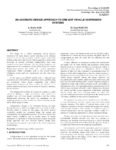
|
An Axiomatic Design Approach To One-DOF Vehicle Suspension Systems
Kar, A. K., Martin, H. E.
1st International Conference on Axiomatic Design, 2000
The design of a vehicle suspension system requires satisfaction of many design aspects including good vibration isolation to secure the occupants comfort, good road-vehicle holding ability and safety. Several vehicle suspension models with structural or actively controlled configurations have been reported in the open literature. The key design objectives are represented by the acceleration of the vehicle body and relative displacement between the vehicle and various suspension components. Other constraints such as the overall system robustness, power and cost requirements are also taken into account. In this paper, two 1-DOF models with a Maxwell type suspension and a Maxwell type suspension with a parallel spring are considered. Mean square acceleration and relative displacement responses of these models are derived for a realistic random road input given in terms of its power spectrum density function.
The optimization problem of suspension systems is usually solved by defining a single performance index which is a weighted sum of mean square acceleration and the relative displacement. However, the results are dependent on the weighting coefficient which is arbitrary; and the solution can not tell us which design is better.
Independence Axiom of the Axiomatic Design can easily distinguish between different designs and can provide an index showing which is better. In this paper, the above derived suspension models are examined using this axiom, and semangularity and reangularity concepts. It has been shown that under certain conditions and in certain range of design parameters, it is possible to obtain decoupled designs. Axiomatic design approach and new relations derived during these investigations may provide a new look at the vehicle suspension system design.
|
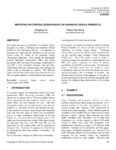
|
Improving An Existing Design Based on Axiomatic Design Principles
Liu, X., Soderborg, N.
1st International Conference on Axiomatic Design, 2000
This paper presents an application of axiomatic design principles to a Noise, Vibration, and Harshness (NVH) problem in the automotive industry. An approach is illustrated for improving the robustness of an existing system design by means of the axiomatic design “decoupling” philosophy. First, identify the relationship between functional requirements (FRs) and design parameters (DPs) in terms of percentage contribution of each DP to each functional response; then put these contribution values into a design matrix and rearrange the matrix to be as triangular as possible. The obtained matrix will demonstrate the relationship between FRs and DPs and guide engineers in making design improvements.
|
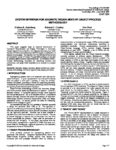
|
System Definition for Axiomatic Design Aided by Object-Process Methodology
oderborg, N., Crawley, E. F., Dori, D.
2nd International Conference on Axiomatic Design, 2002
This paper suggests ways to improve formulation of Functional Requirements and Design Parameters in Axiomatic Design based on the contention that adequate descriptions of both function (WHAT) and architecture (HOW) require a combination of objects and processes. We describe how the definitional framework and expressive power of Object-Process Methodology can be used to represent system function and architecture. We introduce Object-Process Methodology templates for describing function and architecture, and apply these templates as an example to a simple system.
|
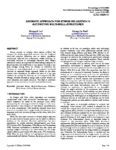
|
Axiomatic Approach for Stress Relaxation in Automotive Multi-shell-structures
Lee, Hyungyil, Gyung-Jin Park
3rd International Conference on Axiomatic Design, 2004
Recent attempt to enhance safety against collision has reshaped the simple single-shell structure into the integrated multi-shell structure. Moreover, due to various regulations continuously tightened for environment, weight reduction of automobile becomes an increasingly important issue. Weight reduction is mainly accomplished by better redesign, adoption of lighter materials, and small-sizing of auto (parts). Focusing on the local redesign among three, we attempt to determine the thickness of each subpart-shell of an integrated multi-shell structure by axiomatic design approach. Based on the finite element stress calculations, we relieve the stress of a box type subframe by varying the thickness of each subpart-shell. The redesign method successfully brings both a preset amount of stress relaxation and weight reduction. This kind of axiomatic approach can be extended to the other multi-shell structures.
|
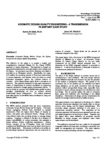
|
Axiomatic Design Quality Engineering – a Transmission Planetary Case Study
El-Haik, B., Wasiloff, J. M.
3rd International Conference on Axiomatic Design, 2004
The objective of this paper is to present a simple and comprehensive integrated Design for Six Sigma (DFSS) approach to design robustness. The approach is hinged on conceptual components for axiomatic design, robust design and Six Sigma. An automatic transmission planetary case study is provided as an illustration vehicle. Specifically, this paper will explore the cascading process of functional requirements to design parameters and features while providing an initial robustness assessment against the common sources of variation. A Six Sigma design quality level is pursued as an objective. The approach presented in this paper represents a stream of development to achieve excellence by improving customer satisfaction through quality enhancement efforts. It can be viewed as a process with detailed steps needed to cast a complete understanding of how to achieve desired breakthrough design improvement. The method presented here relies heavily on the DFSS theory developed by Yang and El-Haik (2003).
|
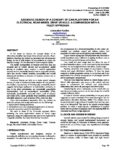
|
Axiomatic Design of a Concept of Car-platform for an Electrical Rear-wheel Drive Vehicle: A Comparison with a Fuzzy Approach
Naddeo, A.
3rd International Conference on Axiomatic Design, 2004
In this paper we analyze the concept design of an
alternative propelled rear-wheel drive vehicle’s chassis, of carplatform,
focusing the interest on pavement and sub-pavement
design, so that it will contain 18 accumulators to supply the
electrical energy ( for the electrical or hybrid engine) needed.
|
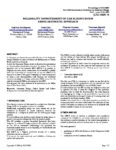
|
Reliability Improvement of Car Sliding Door Using Axiomatic Approach
Arcidiacono, G., Citti, P., Fontana, V., Martelli, T.
3rd International Conference on Axiomatic Design, 2004
In this paper, we discuss the potential utilization of the Axiomatic Design methods in order to enhance the development of Failure Modes and Effects Analysis. At first the Axiomatic Design allows to describe the optimisation of decomposition physical-functional of the project. Due to this operation and to the esteemed RPN (RPNe) it is possible to enlighten the most critical components, so to establish a priority order for intervening on components. To use the FMEA it is important to have a very good knowledge of these components to make a new decomposition until reaching the functional requirements (FRs) and design parameters (DPs) leaves. At this state we must apply FMEA, calculating the true RPN. This approach has been validated by its application to the sliding door of Fiat Auto vehicle.
|
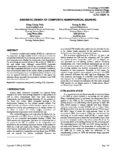
|
Axiomatic Design of Composite Hemispherical Bearing
Park, D. C., Kim, S. S., Kim, J. W., Lee, D. G.
3rd International Conference on Axiomatic Design, 2004
Composite hemispherical bearings (CHB) are employed for the suspension of high mobility tracked vehicles to transfer the compressive load from the connecting rod to the piston in an inarm suspension unit. During the compressive load transmission, the connecting rod journal rotates on the surface of CHB like a ball and socket joint. Although carbon-PEEK composite materials have been mainly used for the conventional CHB due to their high compressive strength as well as low friction coefficient, they are frequently failed by the surface cracks generated during the manufacturing process of hemispherical shape at lower cycles than its required endurance life. Therefore, in this paper, the axiomatic design approach was employed to develop a new CHB with enhanced endurance life.
|
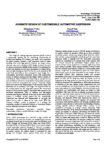
|
Axiomatic Design of Customizable Automotive Suspension
Deo, H., Suh, N. P
3rd International Conference on Axiomatic Design, 2004
The design of existing suspension systems typically involves a compromise solution for the conflicting requirements of comfort and handling. For instance, cars need a soft suspension for better comfort, whereas a stiff suspension leads to better handling. Cars need high ground clearance on rough terrain, whereas a low center of gravity (CG) height is desired for swift cornering and dynamic stability at high speeds. It is advantageous to have low damping for low force transmission to vehicle frame, whereas high damping is desired for fast decay of oscillations. To avoid these trade-offs, we have proposed a novel design for a customizable automotive suspension system with independent control of stiffness, damping and ride-height, which is capable of providing the desired performance depending on user preference, road conditions and maneuvering inputs. A suspension prototype has been built to demonstrate the concept. Axiomatic design theory was used for the development of the concept, design and fabrication of the prototype and design and implementation of the control system for the suspension system. The mechanical design of the proposed system is decoupled with respect to the functional requirements (FRs) of stiffness and ride-height; moreover ride-height is affected by the load on the vehicle (noise factor). A feedback control system for the customizable suspension was designed and implemented to uncouple the system and to make it robust to the noise factor. With this example, feedback control is proposed as a strategy for converting coupled or decoupled designs to uncoupled designs and for achieving robustness to noise factors.
|
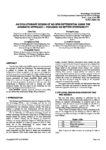
|
An Evolutionary Design of No Spin Differential Using The Axiomatic Approach — Focusing on Better Steerability
Cho, I., Jang, Y., Park, J., Combs, J. A., Pyoun, Y.
3rd International Conference on Axiomatic Design, 2004
Two No Spin Differential (NSD) models were benchmarked for a project of Dual-Use Technology. The Axiomatic approach is utilized to evaluate the designs of the models. The Independence Axiom is satisfied at the top level of design but not at the second level, which implies the design exhibits coupling and will admit design improvements. New design parameters and process parameters for better steerability which satisfy the independent axiom are developed. How to obtain the optimal value of process parameter are presented with one case. Test methodology is developed and used to evaluate the newly developed sample. The test results on the steerability are very positive regarding functional performances.
|
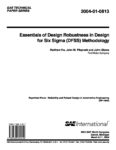
|
Essentials of Design Robustness in Design for Six Sigma (DFSS) Methodology
Matthew Hu, John M. Pieprzak and John Glowa
Tech Papers
Ford Motor Company, 2004 SAE World Congress, Detroit, Michigan, March 8-11, 2004
Design for Six Sigma (DFSS) is a systematic process and a disciplined problem prevention approach to achieve business excellence. Robust design is the heart of DFSS. To enable the success of robust parameter design, one should start with good design concept. Axiomatic Design, a fundamental set of principles that determine good design practice, can help to facilitate a project team to accelerate the generation of good design concept. Axiomatic Design holds that uncoupled designs are to be preferred over coupled design. Although uncoupled designs are not always possible, application of axiomatic design principles in DFSS presents an approach to help DFSS team focus on functional requirements to achieve design intents and maximize product reliability. As a result of the application of axiomatic design followed by parameter design, the DFSS team achieved design robustness and reliability. A hydraulic lash adjuster case study will be presented.
|